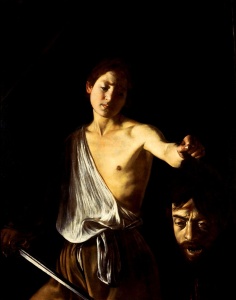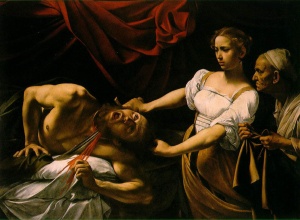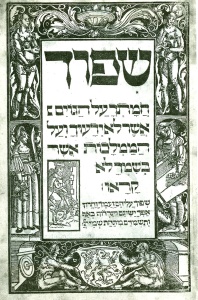Caravaggio and Evil
Michelangelo Merisi Caravaggio (1571-1610) was well acquainted with evil. His short violent life careened wildly between prestigious painting commissions from the most powerful men in Rome and drunken street brawls with the lowest of the low.

Such behavior led to frequent encounters with the police, lawsuits, duels and finally murder. Exposed early in life to both the deep piety of his small hometown of Caravaggio and the violent tumultuous city life of nearby Milan, his view of life was a kind of brash cosmopolitanism laced with the passionate fervor of the Counter Reformation. Within a few years of his arrival in Rome his starkly realistic depictions of contemporary scenes dramatically set in high contrasts of light and dark gained him immediate fame. As he matured an uneasy synthesis of opposites emerged in some paintings, exhibiting a pictorial paradox that points the way to what one could call a modern sensibility of doubt, unease and disquiet. This is perhaps nowhere more evident than in two paintings created only six years apart and yet separated by one event that would cut his life tragically short. Judith and Holofernes (1599) and David with the Head of Goliath (1606) speak to us across the centuries about the unexpected consequences of eradicating evil from our midst. Additionally, the dialogue between the two paintings addresses the multifaceted nature of evil itself.

“Judith” is a Jewish book, originally written in Hebrew but only known to us now in Greek versions that date from the Second Temple period. The narrative relates how Nebuchadnezzar, king of Assyria, intent on ruling the entire world, sends his general Holofernes to conquer Israel. Holofernes besieges the strategic town of Bethulia that blocks his advance on Jerusalem. Once water and food run out the town leaders were desperate, ready to open the gates to the murderous hordes. The beautiful and virtuous widow Judith steps forward with a plan. After convincing the elders to allow her to approach the enemy camp, she prays to God for success in overcoming the general Holofernes, just as God had granted success to her ancestor Simon when he avenged the rape of Dinah. As she enters the camp her beauty beguiles all who see her and she is immediately ushered into a lavish banquet with Holofernes. He is impressed with her beauty, wit and piety (she insists on kosher food she brought for herself). In anticipation of seducing her, he consumes much wine and retires in a drunken stupor. She enters his bedchamber alone, takes his sword and prays again; “Strengthen me this day, O God of Israel! Then with all her might she struck him twice in the neck and cut off his head.” (Judith 13: 6-9) Her maidservant enters and collects his head. Once out of the camp, the decapitated head is displayed for all to see and the invading army flees in terror. Jerusalem, the Temple and the Jewish People have been saved by the courage of Judith.

The Book of Judith is not found in the Jewish canon (possibly because of the prominent use of a sword by a woman, a violation of the prohibition in Deuteronomy 22:5, of kli gever, or the use of man’s equipment for women). Nonetheless, it is seen in numerous Jewish contexts. The story is illustrated in the Rothschild Miscellany (1450-80) and The Prague Haggadah, printed in 1526, shows Judith posed with her sword and the head of Holofernes on the page illuminating the verse “Pour out your wrath upon the nations…” She stands opposite Samson who similarly defended the Jewish people from the attacks of their enemies. This motif appears atop numerous 18th century menorahs (her connection with Judah Maccabee is obvious), especially on the beautiful silver Boller Menorah (1706-1732) found in the Jewish Museum. The story is extensively illustrated in Christian art as a motif of virtue overcoming evil. The artists include; Donatello, Mantegna, Ghirlandaio, Botticelli, Giorgione, Lucas Cranach the Elder, Correggio, and notably Michelangelo’s pairing of Judith and Holofernes opposite David and Goliath on the ceiling of the Sistine Chapel.
Caravaggio’s depiction is startling for both its violence and complexity. In this one painting the artist presents three points of view concerning of the eradication of evil; the victim, the old hag and the young heroine. The handsome Holofernes, suddenly awakened, is shocked in his own death. In mid-scream, he grasps the bed sheets that were agents in his own destruction, a river of blood spurting from his neck separated from his head. Anxiously observing the assassination, the old maidservant eagerly awaits the prize. She represents a mature woman well acquainted with male barbarism, lust and violence. In her angry eyes this is an act of judgment, if not vengeance. It is she who will fittingly receive his severed head.
Judith’s ambiguity is disarming. The strength of her arms holding his hair and slicing with the sword signify exactly how determined and sure she is. Yet she pulls back, her brow furrowed in consternation. She is recoiled by the reality of a life coming to an end. Her youth, grace and beauty all bespeak the feminine role to give life, to fulfill and create. Nonetheless, to save her people, she must deny her essence, she must annihilate him and destroy the threat of his army. Bravely, she grasps his head as she would a piece of meat to slice for dinner.
Unlike most religious paintings of the Counter Reformation, this Caravaggio is not triumphant and self assured. It recognizes that even when one must decide to confront evil and obliterate it, the act of violence necessarily affects us. With Judith, after this heroic act she is no longer simply the young lovely widow. Thrust into history her youthful innocence is tarnished.
David and Goliath, painted six years later, elevates his examination of evil to an intensely personal level. In May 1606 Caravaggio was involved in a brawl that escalated into a sword fight in which Ranuccio Tomassoni was killed. Caravaggio fled Rome, eventually reaching Naples and spending a year there. Early in this period he painted this work allegedly to be sent to the papal court in a plea to annul his sentence, as a kind of pictorial confession of his remorse.
David here is but a young lad, forced to confront the wicked Goliath who taunts him, saying; “Am I a dog that you come after me with sticks? And the Philistine cursed David by his gods…. come to me, so I may offer your flesh to the fowl of the heavens and to the beast of the field!” He was determined to further disgrace Israel and so David was forced to defend his people and their honor, and indeed he triumphed. Goliath was slain by a well aimed sling-shot. David decapitated him and thereby terrified the Philistine army into a chaotic defeat. (Samuel I 17:41-54)
But again Caravaggio’s David is no poster boy hero. With sad eyes and furrowed brow, he sorrowfully gazes at the head of the stricken Goliath, practically asking him, why did you force me to slay you… why did you challenge God’s people? The sharp angle of the sword parallels David’s outstretched arm holding Goliath’s expressive head, creating the graphic metaphor that David could not have truly contemplated the personality of Goliath without first killing him. The meaning of this gesture deepens once we become aware that the face of Goliath is a self-portrait of the thirty-five year old Caravaggio, weary, worn and defeated.
The enormous empathy one feels for both David and Goliath allows us to see Caravaggio pondering his own image, mourning how the evil that seems so deeply ingrained must be eradicated, indeed, must die.
The parallels between the two paintings are startling. Each involve decapitation, each grasps the hair of the victim, each utilizes the sword and arms as parallel agents of destruction, each involves a hesitant executioner, each knocks the evil protagonist out with either wine or a stone, and finally each painting gives us insight into the emotions of the “victim.” Indeed, in each painting one might say that the protagonist is also trapped in the role of victim.
But there are important differences. Judith is young and innocent of death, forced to eradicate an animal force that would consume her before destroying her people. Caravaggio’s David is different. For him the conflict seems more of a personal struggle within the artist himself, a failure to control that which corrodes and slays the soul. Judith had to kill an illicit passion whereas David put to the sword his own hubris. These paintings contrast the evil within and the evil without.
There are some who say that the painting of David and Goliath foretells Caravaggio’s own demise. In the four years left of his life Caravaggio continuously implored his influential friends to obtain a papal pardon from the death sentence he incurred. He fled to the island of Malta and then Sicily and finally back to Naples. In each location he painted a handful of portraits and many masterpieces of religious art. His output was strong and confident. Yet he felt he had to plead his case in person and remove the shadow that hung over his life. A pardon seemed imminent and so he set out to return to Rome. He never made it. He died mysteriously, perhaps of malaria, perhaps murdered. His body was never found. At thirty-nine the evil of violence finally consumed him.
But he left a brilliant record in these two paintings of his confrontation with the evil that still stalks our world and still haunts our souls.